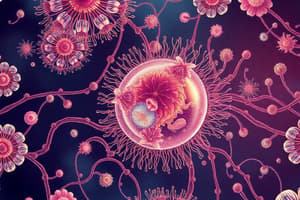Podcast
Questions and Answers
Which of the following structures is present in plant cells but not in animal cells?
Which of the following structures is present in plant cells but not in animal cells?
- Mitochondria
- Cell wall (correct)
- Cell membrane
- Nucleus
Cell division contributes to the growth and repair of multicellular organisms.
Cell division contributes to the growth and repair of multicellular organisms.
True (A)
What is the main function of chloroplasts in plant cells?
What is the main function of chloroplasts in plant cells?
photosynthesis
The organization of cells into tissues, organs, and organ systems allows multicellular organisms to maintain complex ______ and functions.
The organization of cells into tissues, organs, and organ systems allows multicellular organisms to maintain complex ______ and functions.
Match the cell structures with their primary functions:
Match the cell structures with their primary functions:
Which of the following structures is NOT found in prokaryotic cells?
Which of the following structures is NOT found in prokaryotic cells?
All cells have a cell wall.
All cells have a cell wall.
What is the main function of the mitochondria?
What is the main function of the mitochondria?
The process of converting light energy into chemical energy in plant cells occurs in the ________.
The process of converting light energy into chemical energy in plant cells occurs in the ________.
Match the following organelles with their primary function:
Match the following organelles with their primary function:
Which structure regulates what enters and leaves the cell?
Which structure regulates what enters and leaves the cell?
Metabolism only involves breaking down molecules.
Metabolism only involves breaking down molecules.
What type of cell contains membrane-bound organelles?
What type of cell contains membrane-bound organelles?
Flashcards
Cell Growth
Cell Growth
Cells increase in size and number through cell division.
Cell Wall
Cell Wall
A rigid structure in plant cells made of cellulose for support and protection.
Chloroplasts
Chloroplasts
Organelles in plant cells responsible for photosynthesis, converting sunlight to energy.
Vacuoles
Vacuoles
Signup and view all the flashcards
Cell Organization
Cell Organization
Signup and view all the flashcards
Cell
Cell
Signup and view all the flashcards
Prokaryotic Cells
Prokaryotic Cells
Signup and view all the flashcards
Eukaryotic Cells
Eukaryotic Cells
Signup and view all the flashcards
Cell Membrane
Cell Membrane
Signup and view all the flashcards
Mitochondria
Mitochondria
Signup and view all the flashcards
Ribosomes
Ribosomes
Signup and view all the flashcards
Endoplasmic Reticulum (ER)
Endoplasmic Reticulum (ER)
Signup and view all the flashcards
Study Notes
Cells - Basic Units of Life
- Cells are the fundamental structural and functional units of all living organisms.
- All living organisms are composed of one or more cells.
- Cells carry out all life processes, including growth, reproduction, metabolism, and response to stimuli.
Cell Types
- Two main types of cells exist: prokaryotic and eukaryotic.
- Prokaryotic cells are simpler, smaller, and lack a nucleus and membrane-bound organelles. Examples include bacteria and archaea.
- Eukaryotic cells are more complex, larger, and have a nucleus and membrane-bound organelles. Examples include plant and animal cells.
Cell Structure (Eukaryotic Cell)
- Cell Membrane: A thin, flexible barrier surrounding the cell, controlling what enters and leaves. It is selectively permeable.
- Cytoplasm: The jelly-like substance filling the cell, containing organelles and supporting internal transport.
- Nucleus: The control center of the cell, containing DNA enclosed by a nuclear membrane.
- Mitochondria: The "powerhouses" of the cell, producing energy (ATP) through cellular respiration. They have their own DNA.
- Ribosomes: Small structures involved in protein synthesis, either free-floating or attached to the endoplasmic reticulum. They translate genetic information into proteins.
- Endoplasmic Reticulum (ER): A network of membranes involved in protein and lipid synthesis. Rough ER has ribosomes; smooth ER does not. It transports and modifies proteins and lipid synthesis.
- Golgi Apparatus: Processes, packages, and distributes proteins and lipids.
- Lysosomes: Contain digestive enzymes breaking down waste materials and cellular debris, crucial for waste removal.
- Vacuoles: Storage sacs for water, nutrients, or waste products. Plant cells often have a large central vacuole.
- Chloroplasts (Plant Cells Only): Sites of photosynthesis, converting light energy into chemical energy. They contain chlorophyll, giving plants their green color.
Cell Functions
- Transport: Movement of substances across the cell membrane, including passive and active transport.
- Metabolism: All chemical reactions within the cell to sustain life, encompassing both breaking down molecules for energy and building up molecules for structure and function.
- Growth and Reproduction: Cells increase in size and number (cell division) leading to development and repair in multicellular organisms.
Differences between Plant and Animal Cells
- Cell Wall: Plant cells have a rigid cell wall made of cellulose, providing support and protection. Animal cells lack a cell wall.
- Chloroplasts: Plant cells have chloroplasts for photosynthesis. Animal cells do not.
- Vacuoles: Plant cells typically have a large central vacuole. Animal cells have smaller vacuoles.
Importance of Cells
- Cells are fundamental to all life processes.
- Organization of cells into tissues, organs, and organ systems allows complex structure and function in multicellular organisms.
Studying That Suits You
Use AI to generate personalized quizzes and flashcards to suit your learning preferences.




